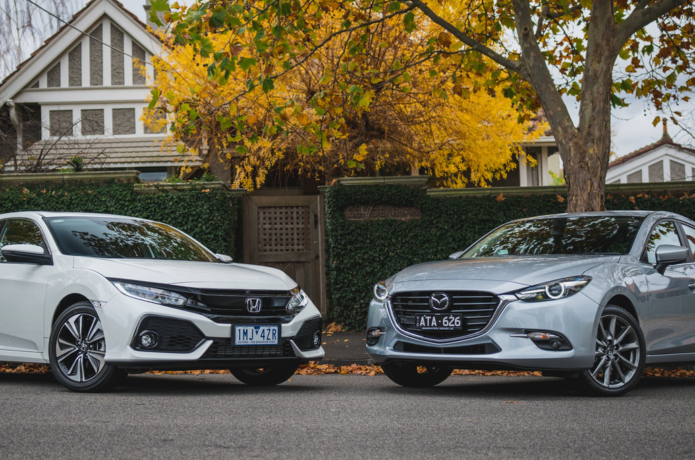[su_youtube url=”https://youtu.be/T15WsanhXsQ”]
Do you hate being stuck in traffic jams? Yeah, me too. But, if you’re going to be driving a small hatchback, why suffer in an entry-level model? This is where moving up in the model range changes a traffic jam from a chore to a treat.
So, if you have around $35,000 burning a hole in your pocket, which premium hatchback should you go for? We lined up the 2018 Honda Civic VTi-LX and the 2018 Mazda 3 SP25 Astina to see which one deserves your hard-earned cash.
As one of the regular best-sellers in the country, the Mazda 3 has seen its fair share of fame. While SUVs are taking over Australian sales charts, hatchbacks still have their place in the minds and hearts of Australians.
Honda‘s new Civic brings a breath of fresh air to the segment with innovation and space, but can it beat the Mazda 3 at its own game? Only one way to find out.
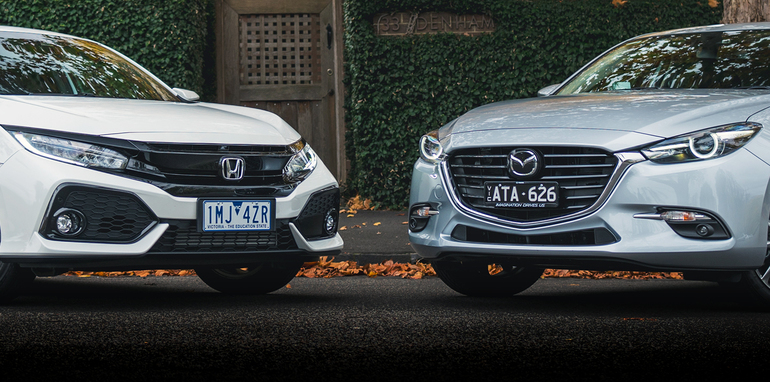
Pricing and specifications
This segment has exploded with new variants and technology that was non-existent in these segments only a few years ago.
Honda’s all-new Civic brings a strong pricing proposition with an automatic-only line-up across two petrol engines – a naturally aspirated four-cylinder petrol and a turbocharged four-cylinder.
The Civic range kicks off from $22,390 (plus on-road costs), climbing all the way up to the top-specification Civic VTi-LX being tested here at $33,590 (plus on-road costs).
You can read about the specification breakdown for each model in our 2018 Honda Civic pricing and specifications article, but the key features fitted to the VTi-LX include:
- Powered door mirrors
- LED daytime running lights
- 7.0-inch touch display with radio, Bluetooth control, Apple CarPlay, Android Auto, two USB ports and one HDMI port
- Hill Start Assist (HSA)
- Steering wheel-mounted controls
- Bluetooth phone connectivity
- Integrated door mirror indicators
- Leather-wrapped steering wheel
- LaneWatch side camera
- Front and rear parking sensors
- Smart keyless entry
- 17-inch alloy wheels
- Sharkfin antenna (VTi, VTi-S have in-glass type)
- Electrically retractable door mirrors
- Automatic wipers and headlights
- Dual-zone climate control
- Automatic up/down function for all windows
- Privacy glass for rear passengers
- Illuminated sun-visor vanity mirror
- DAB+ digital radio
- Dark chrome door handles
- Boot-lid spoiler
- One-touch tilt & opening electric sunroof
- LED headlights with auto levelling
- Drilled alloy pedals
- Eight-way powered driver’s seat
- Black leather-appointed seats
- Heated front seats
- Leather-wrapped gear knob
- Central exhaust outlets
- Piano-black side skirts
- Black front and rear lower spoilers
- 12-speaker stereo with subwoofer
- Adaptive cruise control
- Auto dimming rear-view mirror
- Garmin satellite navigation with SUNA traffic alerts and turn-by-turn navigation
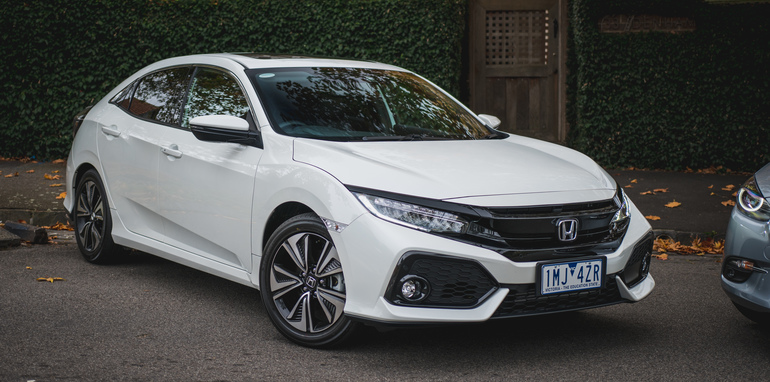
Safety:
- Front, side, full-length curtain airbags
- Vehicle Stability Assist (VSA)
- Agile Handling Assist System (AHAS)
- Anti-lock Braking System (ABS)
- Electric Brake-force Distribution (EBD)
- Emergency Brake Assist (EBA)
- Emergency Stop Signal (ESS)
- Traction Control System (TCS)
- Tyre Deflation Warning System (DWS)
- Two ISOFIX points
- Forward Collision Warning (FCW)
- Collision Mitigation Braking System (CMBS)
- Lane Departure Warning (LDW)
- Lane Keeping Assist System (LKAS)
- Road Departure Mitigation System (RDM)
- Adaptive Cruise Control (ACC) with Low-Speed Follow (LSF)
While the VTi-LX is loaded with safety equipment, it lags behind the Mazda 3 across the rest of its range with features like AEB only available on the top-specification VTi-LX model.
That aside, the two engines are chalk and cheese compared to one another. The entry-level 1.8-litre naturally aspirated petrol engine produces 104kW of power and 174Nm of torque, mated to a continuously variable transmission (CVT) and consumes 6.4 litres of fuel per 100km on the combined cycle.
It’s fairly lifeless and dampens what is otherwise a pretty decent package. Thankfully it’s limited to just the entry-level VTi and VTi-S models.
Step up to the RS, VTi-L and VTi-LX and that engine transforms into a turbocharged 1.5-litre four-cylinder petrol that produces 127kW of power and 220Nm of torque, also mated to a CVT. It’s a far better match for the package and delivers a hearty punch across its rev band, consuming 6.1L/100km on the combined cycle.
In terms of size, the Civic is bigger than it looks.
- Length: 4515mm
- Width: 1799mm
- Height: 1421mm
- Wheelbase: 2700mm
- Weight: 1266kg
- Cargo: 414 litres
- Towing: 800kg (braked), 500kg (unbraked)
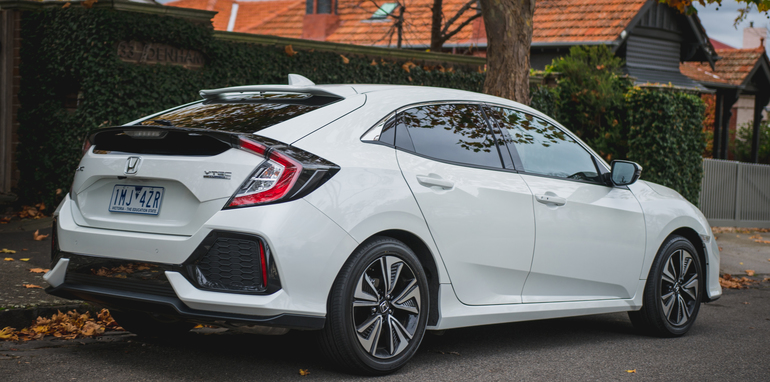
Over in the other corner of the ring, Mazda’s 3 range kicks off from $20,490 (plus on-road costs) and comes with the option of either a six-speed manual or six-speed automatic gearbox (an additional $2000). The engine range includes a 2.0-litre naturally aspirated four-cylinder petrol engine or a 2.5-litre four-cylinder naturally aspirated petrol engine.
The top-specification model tested here, the Mazda 3 SP25 Astina, is priced from $33,490 (plus on-road costs) for the six-speed manual and $35,490 (plus on-road costs) for the six-speed automatic. Like the Civic, it’s loaded with standard features, including:
- Electric folding mirrors (body coloured)
- Drive selection switch
- Rear spoiler
- Tilt and telescopic adjustable steering wheel
- Bose AM/FM tuner and nine speakers with auxiliary/Bluetooth/USB
- Steering wheel-mounted audio controls
- Push-button engine start
- Front and rear parking sensors
- Power mirrors (body-coloured, auto-folding)
- Leather-wrapped gear shift knob, handbrake handle and steering wheel
- Paddle-shifters
- 7.0-inch full colour touchscreen display with MZD Connect dial
- Internet radio integration (Pandora, Stitcher and Aha)
- Digital radio (DAB+)
- Satellite-navigation
- Rear-view mirror with auto-dimming function
- Electric sunroof
- Adaptive LED headlights
- 10-way power adjustment for the heated seats
- Radar cruise control
- LED daytime running lights, headlights and fog lights
- Power heated mirrors
- Leather seats with six-way power adjust and heating
- Active Driving Display (HUD)
- Rear-view mirror with auto-dimming function
- 18-inch alloy wheels
- Auto on/off headlights
- Rain-sensing wipers
- Dual-zone climate control
- Advanced keyless entry
- Electric park brake
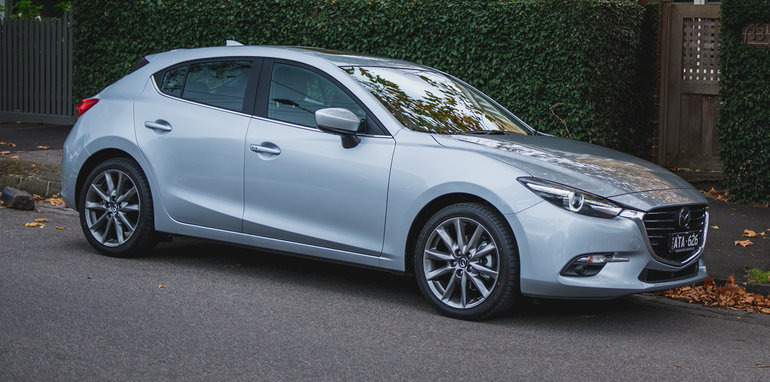
Safety:
- Six airbags
- ISOFIX child restraint anchor points and top tethers
- Reversing camera
- Blind-spot monitoring
- Rear cross-traffic alert
- Lane-keep assist
- Traffic sign recognition
- Driver-attention alert
- G-Vectoring Control
- Smart City Brake Support – forward and reverse
You can see features fitted to other Mazda 3 models in our 2018 Mazda 3 pricing and specifications article. It’s great to see Mazda leading on the front foot in this segment with AEB fitted as standard across the entire Mazda 3 range.
At the entry level, Mazda uses a 2.0-litre naturally aspirated four-cylinder petrol engine that produces 114kW of power and 200Nm of torque, available with either a six-speed manual or six-speed automatic transmission. Fuel consumption comes in at 5.9L/100km for the manual and 5.8L/100km for the automatic.
Stepping up in the range increases engine size and output, with a 2.5-litre four-cylinder naturally aspirated petrol that produces 138kW of power and 250Nm of torque, using either a six-speed manual or six-speed automatic transmission. Combined fuel consumption is 6.5L/100km for the manual and 6.1L/100km for the automatic.
Size-wise, the Mazda 3 is a smaller package than the Civic.
- Length: 4470mm
- Width: 1795mm
- Height: 1450mm
- Wheelbase: 2700mm
- Weight: 1328kg
- Cargo: 308 litres
- Towing: 1200kg (braked), 600kg (unbraked)
While the Mazda 3 SP25 Astina is well equipped, it’s almost $2000 more than the Honda. It also lags behind the Honda for warranty and included roadside assistance (more on this later).
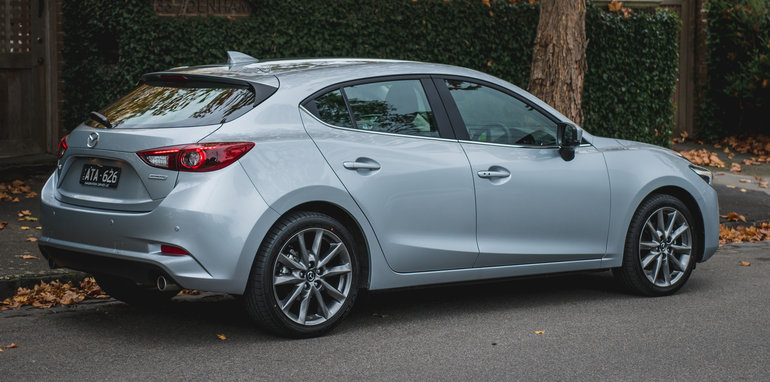
Interior
There isn’t as big a difference between these two in terms of interior fit and finish. We were surprised at how solid and premium both vehicles feel.
Honda and Mazda have both invested heavily in increasing the durability and premium finish of all touchpoints. Soft centre console lids and door finishes give both cabins an air of luxury. While production standards have increased immensely out of Thailand (it’s where most of our local dual-cab utes are produced), it’s worth noting that the Mazda 3 is still built in Japan, while the Civic is built in Thailand.
Honda uses a clean finish across the dashboard with a minimum of buttons and clutter. A lot of functions are built into the central 7.0-inch colour touchscreen used for the infotainment.
It’s an easy-to-use unit with built-in Apple CarPlay and Android Auto, which makes functionality a breeze. There’s also a clever inbuilt satellite navigation system by Garmin that uses real-time traffic information to plot the fastest route.
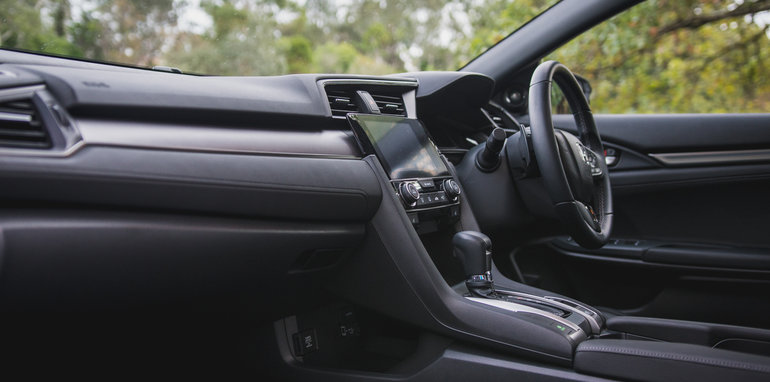
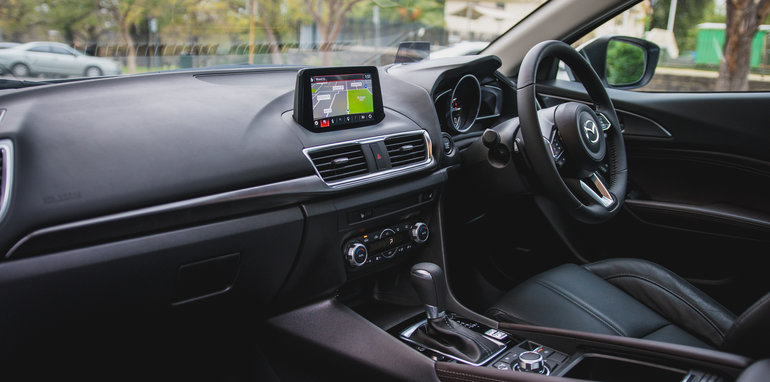
Above and in all sets: Honda Civic top, Mazda 3 bottom
It’s complete with USB ports for charging and media access, a HDMI port and Bluetooth plus auxiliary input.
Ahead of the driver is a colour LCD screen that displays the key vehicle information. It’s quite innovative and gives the cabin a ‘fun’ feel with lights that change colour depending on instant fuel economy.
Storage throughout the cabin is great. A huge centre console offers deep storage with a closing lid and room for your odds and ends.
Visibility out the front, sides and rear is great, with a high-quality reverse-view camera and both front and rear parking sensors.
Surprisingly, the second row offers decent amounts of space with ample leg and shoulder room. With my seat in a far-back driving position, I was able to fit in the back with enough room to be comfortable (I’m around 185cm tall), but it was let down by a lack of head room due to the sloping roof line.
The second row folds in a 60/40 split-folding configuration with a centre armrest. ISOFIX is available for the two outboard seats, but there’s a distinct lack of air vents for the second row in both the Civic and Mazda 3.
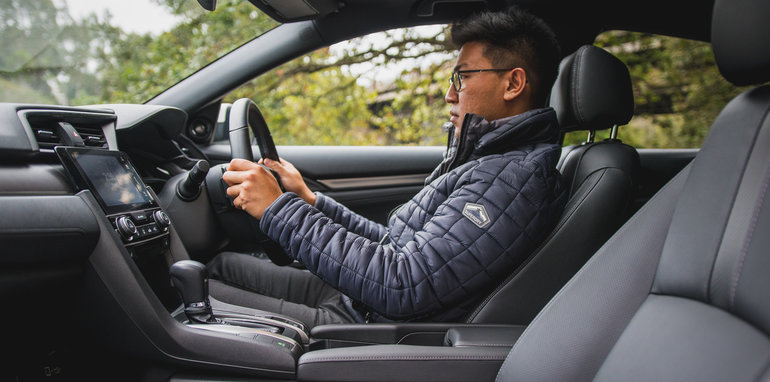
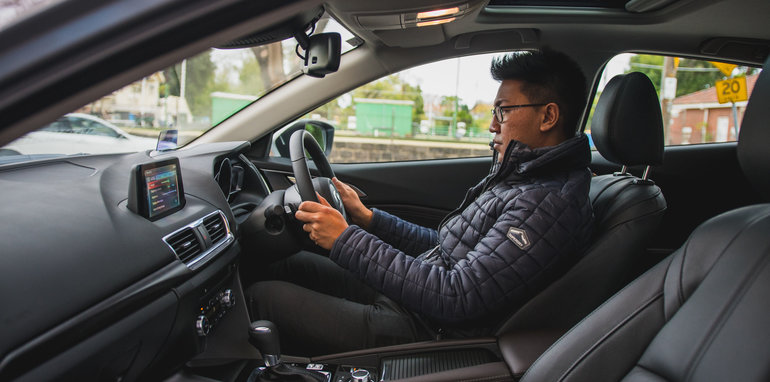
Cargo capacity measures in at 414 litres, which is huge for a hatch. There’s also a clever cargo blind system that pulls into place, unlike the ungainly cargo blind used in the Mazda 3. Both cars also feature space-saver spare tyres.
Hop onto the front seat of the Mazda and it feels like a familiar space. The design of the Mazda 3’s interior has barely changed over the past five years, so it’s all pretty similar.
Mazda announced earlier this year that it will fit Apple CarPlay and Android Auto to any vehicle fitted with MZD Connect by the end of this year for an undisclosed fee. That’s great news and solves one of our major gripes with the system.
MZD Connect uses a 7.0-inch display in the Mazda 3, which offers touchscreen functionality that operates while the vehicle is stationary only. It’s controlled using a central dial with shortcut buttons.

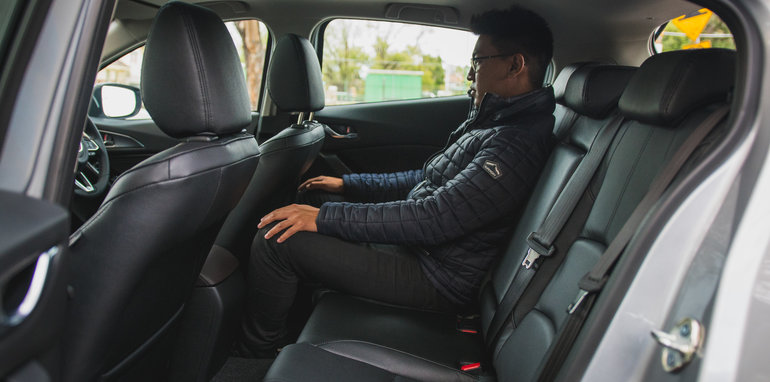
It was a breakthrough for this segment five years ago, but today it can be quite clumsy and misses out on some of the functionality of its peers. For example, you can’t use voice control in some menus and you’re unable to pass voice commands through to Siri or the Google equivalent.
That aside, the Mazda 3 uses a head-up display that shows traffic sign information. It’s a handy feature to have, but the fold-up screen looks a little bit cheap in comparison to other head-up implementations that are built into the dashboard.
There’s plenty of storage throughout the cabin, with a deep centre console that offers USB connectivity and a 12V outlet.
Jump over to the second row and it’s a very cramped space if you’re taller than you are shorter. I found it hard to fit behind the driver’s seat with it in my regular position.
The 60/40 split-folding seats feature a centre armrest and ISOFIX points on the two outer seating positions. Cargo capacity is a measly 308 litres – a full 100 litres short of the Civic.
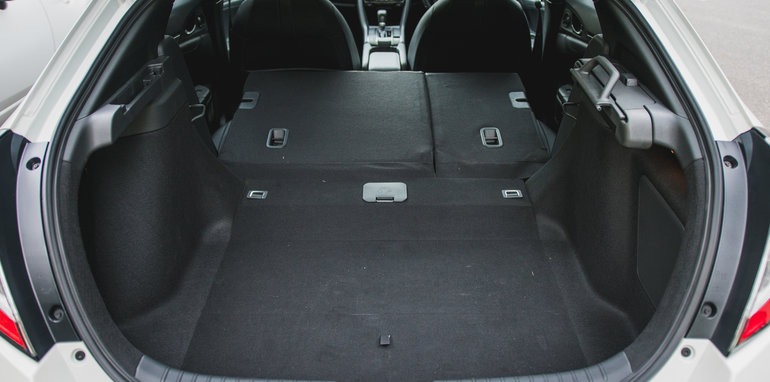
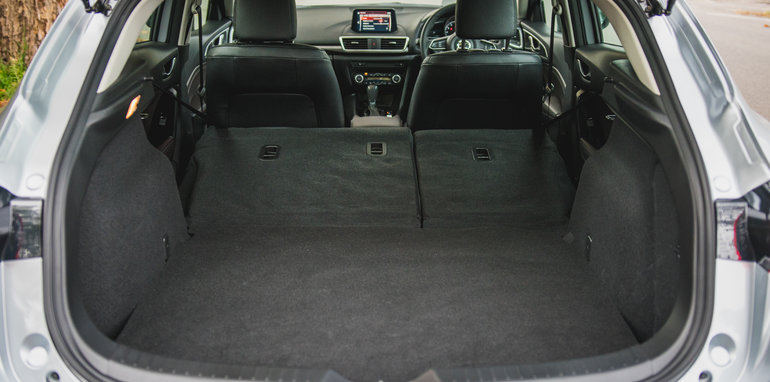
On the road
Hit the open road and it’s surprising how good both of these cars feel with a few miles under their belts. Both vehicles offer excellent ride compliance, with a lot of thought put into the way they take on potholes and corrugations on country roads.
Despite riding on 17-inch alloy wheels, the Civic does a good job keeping itself planted without transmitting too much harshness into the cabin. Its ride is on the soft side with plenty of communication through the wheel. What really surprised us was how eager the turbocharged petrol in the Civic is.
We used to cringe at some CVT transmissions, but the one in the Civic does an excellent job of delivering torque when it’s required without screaming at you through the cabin.
Despite plenty of insulation, the ride can be a little noisy at times, especially on coarse-chip roads. It transmits a booming noise into the cabin, and while it’s not as noisy as the Mazda 3, it’s certainly noticeable.
Part of the key difference between these two cars (aside from the turbocharger) is almost 100kg of mass. The lighter Civic copes better with sudden requests for torque and feels more nimble for it. Both vehicles happily overtake and don’t hit you with surges of torque, which is great news.
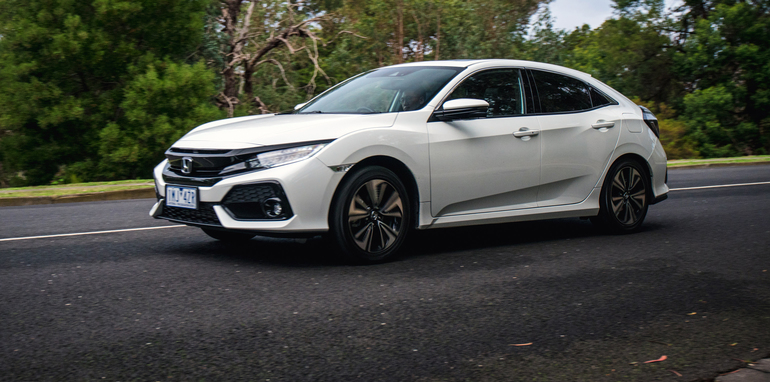
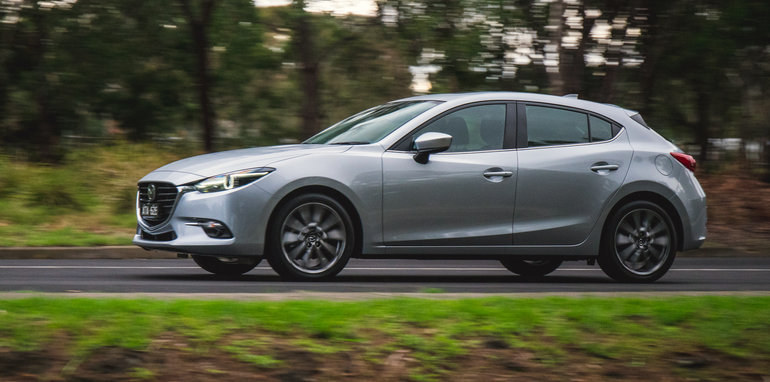
In and around the city, both cars are easy to place and are nimble enough to dart in and out of traffic. The Civic feels easier to see out of, whereas the Mazda 3 feels like it closes in around you more.
Driving the Mazda is a completely different experience with the smooth, naturally aspirated engine delivering linear acceleration and lots of in-gear torque. The six-speed automatic is quick and decisive, and provides engagement when you slide over to the manual mode.
While it’s heavier than the Civic, the engine is responsive and it’s hard to beat the torque delivery of a naturally aspirated engine – especially one with a hearty 250Nm of torque.
It rides just as nicely as the Civic, but like a number of other Mazdas, it can be quite noisy in the cabin over coarse roads at highway speeds.
The ride is great and handles the ins and outs of city life happily. Find yourself a winding country road and it’s a fun car to drive as the speeds pick up. It feels more engaging than the Civic, and if an occasional mountain blast is your thing, it’s the chassis you’re going to want beneath you every time.
Fuel economy is good on paper, but we were seeing closer to 8–9L/100km on test with a mix of city and highway driving. The Civic, on the other hand, came in at around the 7L/100km mark with the same mix of driving.
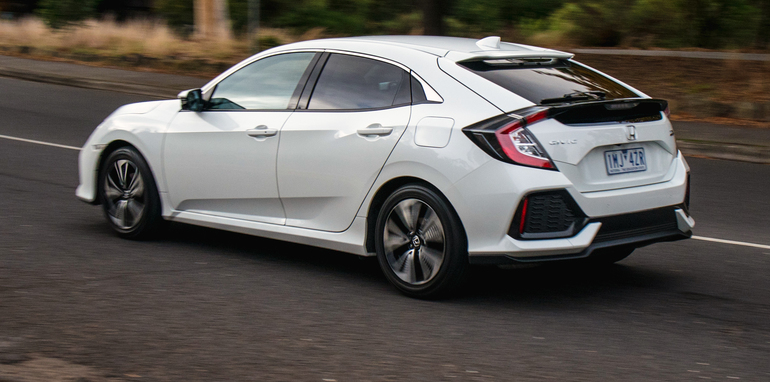
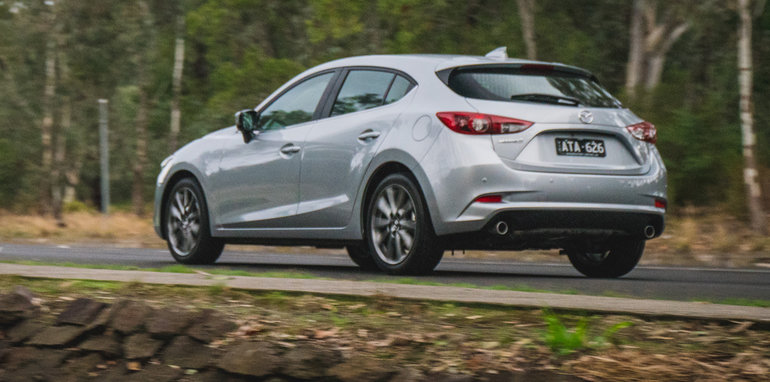
Ownership
Ownership is where the divide begins to appear with these two.
Honda has recently stepped up the game with a permanent five-year/unlimited-kilometre warranty with no roadside assistance. Servicing occurs every 10,000km or 12 months (whichever occurs first) with five years of servicing coming in at $1405.
Mazda, on the other hand, only offers a three-year/unlimited-kilometre warranty with no roadside assistance. Servicing occurs every 10,000km or 12 months (whichever comes first) with five years of servicing costing $1596.
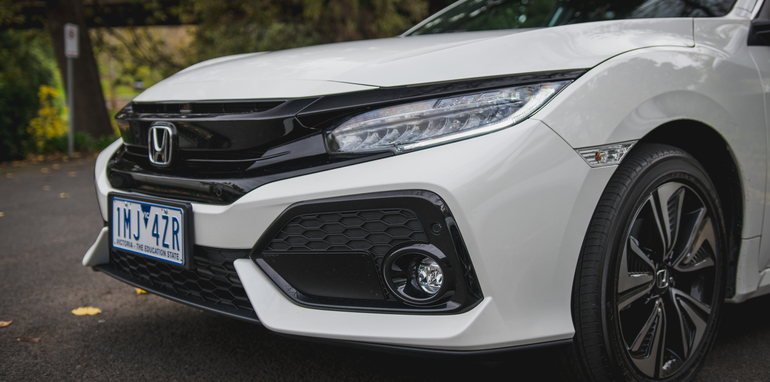
VERDICT
This comparison proves that buying what everybody else buys isn’t always the best idea.
While the Mazda 3 offers style, presence and a great drive, it’s let down by expensive pricing and misses out on some modern features and technology fitted to the Honda Civic.
Mazda also lacks the warranty coverage of its key competitors, and is slowly becoming one of the few top Australian brands to offer less than a five-year warranty.
In this instance, the Honda Civic VTi-LX is a better all-rounder that hits the brief in terms of equipment, drivetrain and space. And that’s why it takes out this comparison.
(caradvice.com.au, http://bit.ly/2zwgdrT)


